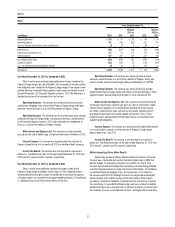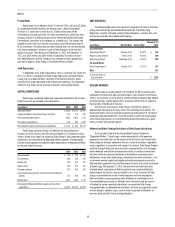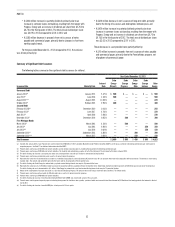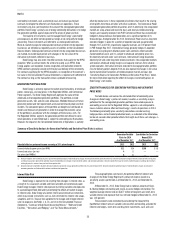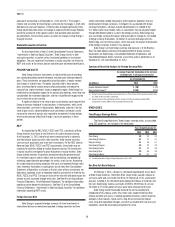Duke Energy 2013 Annual Report Download - page 64
Download and view the complete annual report
Please find page 64 of the 2013 Duke Energy annual report below. You can navigate through the pages in the report by either clicking on the pages listed below, or by using the keyword search tool below to find specific information within the annual report.
46
PART II
During 2012, Duke Energy recorded $12,469 million of goodwill associated
with the merger with Progress Energy. This goodwill represents the excess of
the purchase price over the estimated fair values of the assets acquired and
liabilities assumed on the acquisition date, and was allocated entirely to the
Regulated Utilities segment. The remainder of Regulated Utilities’ goodwill relates
to the acquisition of Cinergy in April 2006.
Duke Energy allocates goodwill to reporting units, which are a subset of the
business segments and are determined based on how the segment is managed.
Duke Energy is required to test goodwill for impairment at the reporting unit level
at least annually and more frequently if it is more likely than not that the fair
value of a reporting unit is less than its carrying value. Duke Energy performs its
annual impairment test as of August 31.
Application of the goodwill impairment test requires management judgment,
including determining the fair value of the reporting unit, which management
estimates using a weighted combination of the income approach, which estimates
fair value based on discounted cash flows, and the market approach, which
estimates fair value based on market comparables within the utility and energy
industries. Significant assumptions used in these fair value analyses include
discount and growth rates, future rates of return expected to result from ongoing rate
regulation, utility sector market performance and transactions, projected operating
and capital cash flows for Duke Energy’s business and the fair value of debt.
Estimated future cash flows under the income approach are based to a large
extent on Duke Energy’s internal business plan, and adjusted as appropriate for
Duke Energy’s views of market participant assumptions. Duke Energy’s internal
business plan reflects management’s assumptions related to customer usage
and attrition based on internal data and economic data obtained from third-party
sources, projected commodity pricing data and potential changes in environmental
regulations. The business plan assumes the occurrence of certain events in
the future, such as the outcome of future rate filings, future approved rates of
returns on equity, anticipated earnings/returns related to significant future capital
investments, continued recovery of cost of service, the renewal of certain contracts
and the future of renewable tax credits. Management also makes assumptions
regarding operation, maintenance and general and administrative costs based on
the expected outcome of the aforementioned events. In estimating cash flows, Duke
Energy incorporates expected growth rates, regulatory and economic stability, the
ability to renew contracts and other factors, into its revenue and expense forecasts.
One of the most significant assumptions that Duke Energy utilizes in
determining the fair value of its reporting units under the income approach is the
discount rate applied to the estimated future cash flows. Management determines
the appropriate discount rate for each of its reporting units based on the weighted
average cost of capital (WACC) for each individual reporting unit. The WACC takes
into account both the after-tax cost of debt and cost of equity. A major component
of the cost of equity is the current risk-free rate on twenty-year U.S. Treasury
bonds. In the 2013 impairment tests, Duke Energy considered implied WACCs for
certain peer companies in determining the appropriate WACC rates to use in its
analysis. As each reporting unit has a different risk profile based on the nature of
its operations, including factors such as regulation, the WACC for each reporting
unit may differ. Accordingly, the WACCs were adjusted, as appropriate, to account
for company specific risk premiums. For example, Duke Energy Ohio’s transmission
and distribution reporting unit generally would have a lower company specific risk
premium as it does not have the higher level of risk associated with owning and
operating generation assets nor does it have significant construction risk or risk
associated with potential future carbon legislation or pending EPA regulations. The
discount rates used for calculating the fair values as of August 31, 2013, for each
of Duke Energy’s domestic reporting units ranged from 5.4 percent to 7.4 percent.
For Duke Energy’s international operations, a country specific risk
adder based on the average risk premium for each separate country in which
International Energy operates was added to the base discount rate to reflect the
differing risk profiles. This resulted in a discount rate for the August 31, 2013
goodwill impairment test for the international operations of 10.6 percent.
The underlying assumptions and estimates are made as of a point in time.
Subsequent changes, particularly changes in the discount rates, authorized
regulated rates of return or growth rates inherent in management’s estimates of
future cash flows, could result in future impairment charges.
The majority of Duke Energy’s business is in environments that are either
fully or partially rate-regulated. In such environments, revenue requirements are
adjusted periodically by regulators based on factors including levels of costs,
sales volumes and costs of capital. Accordingly, Duke Energy’s regulated utilities
operate to some degree with a buffer from the direct effects, positive or negative,
of significant swings in market or economic conditions. However, changes in
discount rates may have a significant impact on the fair value of equity.
As of August 31, 2013, all of the reporting units’ estimated fair value of
equity exceeded the carrying value of equity by more than 10 percent.
The fair value of Commercial Power’s Renewables reporting unit is
impacted by a multitude of factors, including legislative actions related to tax
credit extensions, long-term growth rate assumptions, the market price of power
and discount rates. As of December 31, 2013, the Renewables reporting unit’s
estimated fair value of equity exceeded the carrying value of equity. Duke Energy
continues to monitor these assumptions for any indicators that the fair value of
the reporting unit could be below the carrying value, and will assess goodwill for
impairment as appropriate.
Long-Lived Asset Impairment Assessments
Property, plant and equipment is stated at the lower of historical cost less
accumulated depreciation or fair value, if impaired. Duke Energy evaluates property,
plant and equipment for impairment when events or changes in circumstances
(such as a significant change in cash flow projections, the determination that it
is more likely than not an asset or asset group will be sold, or a regulating body
with authority to set rates Duke Energy charges to customers approves an order
disallowing recovery of costs incurred or to be incurred) indicate the carrying value
of such assets may not be recoverable. The determination of whether an impairment
has occurred is based on an estimate of undiscounted future cash flows attributable
to the assets, as compared with their carrying value, except when applied to
regulated plant costs that are disallowed for ratemaking purposes. The impairment
for a disallowance of costs for regulated plants under construction, recently
completed or abandoned is based on discounted cash flows. See “Regulatory
Accounting” for information related to accounting for rate regulated operations.
Performing an impairment evaluation involves a significant degree of
estimation and judgment in areas such as identifying circumstances that
indicate an impairment may exist, identifying and grouping affected assets,
and developing the undiscounted future cash flows associated with the asset.
If an impairment has occurred, the amount of the impairment recognized is
determined by estimating the fair value of the asset and recording a loss if
the carrying value is greater than the fair value. Additionally, determining fair
value of the asset requires probability weighting future cash flows to reflect
expectations about possible variations in their amounts or timing and the
selection of an appropriate discount rate. Although cash flow estimates are
based on relevant information available at the time the estimates are made,
estimates of future cash flows are, by nature, highly uncertain and may vary
significantly from actual results. For assets identified as held for sale, the
carrying value is compared to the estimated fair value less cost to sell to
determine if an impairment loss is required. Until the assets are disposed of,
their estimated fair value is re-evaluated when circumstances or events change.
When determining whether an asset or asset group has been impaired,
management groups assets at the lowest level that has discrete cash flows.
For regulated entities, the lowest level with discrete cash flows is generally the
operating utility level.
When it becomes probable that regulated generation, transmission or
distribution assets will be abandoned, the cost of the asset is removed from plant
in service. The value that may be retained as an asset on the balance sheet for the
abandoned property is dependent upon amounts that may be recovered through
regulated rates, including any return. As such, an impairment charge could be
offset by the establishment of a regulatory asset if rate recovery is probable.
As discussed further in Note 2 to the Consolidated Financial Statements,
“Acquisitions, Dispositions, and Sales of Other Assets,” in the first quarter
of 2014, Duke Energy Ohio announced it had initiated a process to exit its
nonregulated Midwest generation business. As a result, Duke Energy expects



